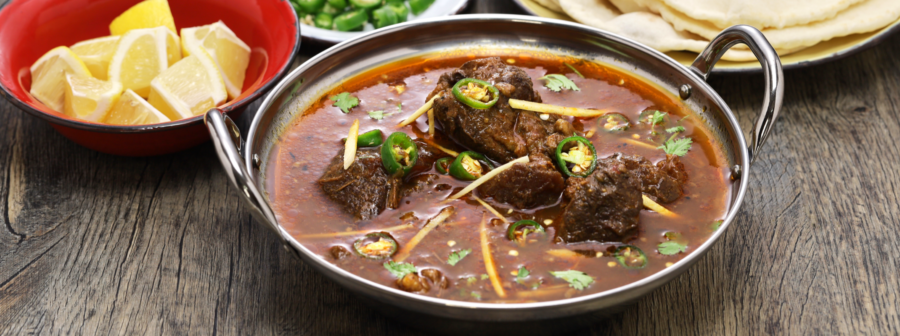I run into the same problem whenever I start making southeast asian food and some middle-eastern dishes—the stuff we get in the U.S. is not the same as the stuff they have there. Amazon will deliver all kinds of fresh spices, which takes planning, but it’s not worth the effort if I have to start with a commercial spice-packet. Anything that was ground up half-a-world away, and only god knows how long ago is a big no. So, the ingredient hunt is a thing, but when fresh, toasting spices start to fill the kitchen with their heady aromas, now we’re talking.
Nihari is a red meat and marrow stew. Make it with goat or lamb to be authentic—(Greek) yoghurt provides the acidity. You’ve got it right if the spiced flavor shines over a broth with buttery texture. Unlike in French cooking, the onion is added at the end like a topping rather than part of the base.
For the Masala
If you take 1-part to be 1 teaspoon or 3 grams, then the following should give you enough masala to flavor 6-8 servings of Nihari. (See note 1)
- 2 Parts Red Chili Powder
- ½ Parts Tumeric
- 1 Parts Ginger Powder
- 9 Parts Fennel Seeds
- 9 Parts Cumin Seeds
- 2 Part Coriander Seed
- ½ Part Cloves
- ½ Part Black Peppercorn
- 1 Part Black Cardamom
- 1/2 Part Green Cardamom
- 1 Part Star Anise
- ½ Part Ground Cinnamon
- ½ Part Nutmeg/Mace Powder 50/50 Blend (note 2)
For the Nihari Stew
- Red meat of your choice for stewing
- Bones with marrow
- Yogurt (Greek variety)
- Wheat Flour as a thickening agent
- Clarified butter (Note 3)
- Onion
Toast the masala ingredients and grind them. Brown the stew meat in clarified butter and toss with the masala. (Note 4) Then mix with enough yogurt to coat and fry off the liquid. Add enough water to cover the meat. Cook until soft. Remove the meat and store. Cook the bones in the remaining liquid until the marrow becomes like butter. (Note 5) Discard the bones, leaving the marrow and replace the meat. Bring to a simmer and add thickener. Salt to taste and then refrigerate at least a few hours, but better the next day. (Note 6) When it’s time to serve, reheat and salt as needed. Fry off some onions in clarified butter and serve on top, maybe dredge them in the flour to make them crispy, why not?
- I relied heavily on Shehar Bano Rizvi’s book Virsa for the Masala. I guess that makes her my Pakistani Ammi—I wish I actually had one.
- Mace powder—for real, the powdered husks of nutmeg seeds. It’s not the stuff that people spray in your eyes when you’re being an ass.
- The French call it clarified butter, in India its ghee.
- The amount of masala (spice mix) depends on what you think a serving size should be. If you’re looking to serve each guest about 150 grams (⅓ lb) of meat, then start with 2 tsp of masala per serving. This is admittedly on the spicier side of safe, as it should be.
- Since I’m not a fan of waiting unnecessarily, I roasted the bones in the oven for 45 minutes, deglazed and then tossed them in the pressure cooker for 4 hours. By then, the marrow slides right out of the bones. Might as well use the pressure cooker for the meat too.
- I left it for 2 days, in the fridge, before serving. I think that may have been excessive. Besides allowing the masala flavor to blend really well, the fridge time lets the the excess tallow to rise to the top and solidify making it easy to remove/repurpose.
For more about Pakistan, click here.







